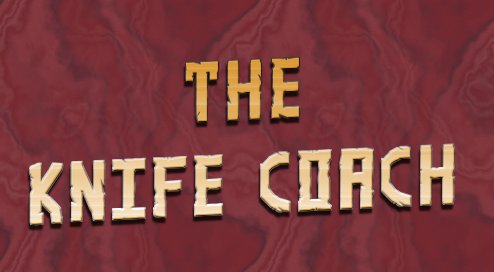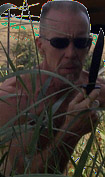

Hello and welcome back! Many of you have emailed me about how much you enjoy the KNIFE COACH articles. Thank you. Let's continue advancing our growth curve with this latest offering!
There are times in life that require the edge of a knife to cut and there are other moments when you need the point of that knife to pierce. Commonly most people who have little or no training wield a knife much like they would a club or axe. Meaning they more or less hit (chop) with the knife rather than cutting (drawing) with it as they should.
Believe it or not cutting requires more skill to execute than does the simpler, more intuitive thrust does. The cut can be disabled by a jacket or heavy coat. Also a cut requires a sharp edge (most men's knives are dull as hell) in order for it to work effectively.
A thrust has none of these issues or limitations, the point does it's magic under nearly any circumstances that you may encounter. Ripping, tearing, picking and piercing. These are the ways of the point and this then is the topic of this session. Point Work and thrusting with point!
The deadly "thrusting triangle" of Kali is a well known example of the knife man's usage of the point. In his quest for victory the knifeman must thoroughly understand the many levels of the mysterious thrusting triangle. Sumkete, sonkete... yes, good old thrusting mixed liberally with enganyo (faking). Also add a dash of slashing intersperced with the three thrusts, connect the dots so to speak. That should round out the game in your favor quite nicely.
Now you have quite a sophisticated web of defense. It contains the elements of deception, the threat of the point, slashes that seem to appear out of the thin air! Now add the checking hand into the mix - Presto! You have the makings of a great means of personal protection from start to finish.
Mind you, it's not just the Filipino arts which employ these methods. All forms of edged weaponry share these traits. Sure they vary slightly from style to style, from teacher to teacher, but generally they are known by all methods and by all men. They are somewhat "instinctual". Men will perform these actions with or without prior training.
Unique to which we speak is the conceptual depth that these methods encompass. It is that very "depth" that many miss and settle instead for the most basic of understandings and applications (edge-ucated idiots). Stop looking AT the exercise and instead look INTO it. And just what are those things which you might find by looking deeply into the thrusting triangle method?
Right off there are a myriad of disarms which await your study. They hide-reside within the thrusting triangle's matrix of motion my dear friend. The retraction of the six and seven thrust actions are the key. Right after the thrust is completed (or even if it is blocked) - now is the time to extract the blade from their trembling grip! And then follow up with another thrust and a line clearing slash. The deed is done, you've won. Either exit the area or apply aid to the injured now.
A thrust (Point) can be given in a fight for a specific reason. A case in point is armor. An armored opponent has taken away some of the better and more accessible targets. By doing so he has gained an advantage. The six and seven lines have the capacity to defeat armor. The line of attack itself can find and exploit an opening or gap in armor, modern or ancient armor, it matters little.
The number five thrust or a common slashing cut do not have the same ability as the other two lines of your triangle. They struggle when armor is present. You must practice and understand "skidding" thrusts. They are meant to skid off the breastplate, gorget or forearm. They seek their targets by sliding over the surface of the body (in this case armor). In Kenpo such an action would be catagorized as "contouring" (following the surface to your target). Such actions like contoured cutting will seek the bone and follow it in fights that lack armored combatants.
Even the visceral vaunted backcut of the Bowie knife fighter can be performed upon the thrusting triangle. I know so for a fact for I've taught it successfully for years. Bill Bagwell himself also states that the backcut is "pointwork" (point oriented) and that it is not really a cut at all, but instead a form of ripping with the point. Like a raptors (eagle, hawk) beak. I totally agree.
And I'll also add that you must understand the true reason of the fighting design of the weapon's butt. Some knives have spikes or sharp ridges on their butt ends. Hell yes, this then is another available point of contact / damage to employ upon the enemy in close quarters using "point" techniques. (Remember not all knives are suited to butt strikes. Use the right unit eh?)
You must try the thrusting triangle with only butt strikes, then only with knife point, next with both point and edge (connect the dots). Lastly you may add a live hand check to the chest or shoulder (in lieu of the face or stomach) - once the live hand begins tossing 1/2 beat strikes on the triangle matrix as the knife simulataneously delivers full beat motions on the same triangle you'll have reached a zenith of timing, skill and lethality. It's not about force, it's about timing.
Learn this tried and true material in graduated levels, one step at a time. And check here on my Youtube channel for some visual hands on tips to get you started. I'm looking forward to seeing you soon. The prime directive of the KNIFE COACH is to help you achieve your goals and to make you better at whatever blade art you do. I am sincerely honored to work with you. Whether it be in person or via DVD or over Youtube, I know that together, we can do this!
Locked-In Learning for You alone directly from the Knife Coach!
Please learn & never forget this knife fighter's mantra from times past:
"If your blade goes forth, withhold your anger. If your anger goes forth, withhold your blade".
Thanx to All for Reading & Watching
I am The KNIFE COACH
..........................................................................................................................................................................................................................
Session # 3
~ Bridging The Gap Between the Slash and the Slap ~
TM